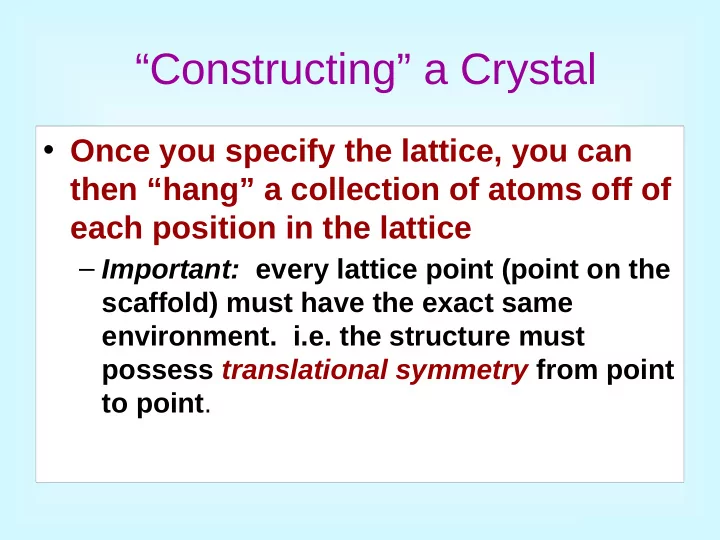

“Constructing” a Crystal • Once you specify the lattice, you can then “hang” a collection of atoms off of each position in the lattice – Important: every lattice point (point on the scaffold) must have the exact same environment. i.e. the structure must possess translational symmetry from point to point . EE-452 13 - 1
Crystal Bravais Lattices • Simple Base Centered Triclinic Monoclinic Simple Body centered Base centered Face Centered Orthorhombic Hexagonal EE-452 13 - 2
Crystal lattices ( cont.) Simple Body Centered Tetragonal Rhombohedral EE-452 13 - 3
Simple Cubic lattices Simple Body-Centered Face-centered EE-452 13 - 4
Atomic Order of a Crystal Structure Plummer Figure 4.2 EE-452 13 - 5
Amorphous Atomic Structure Plummer Figure 4.3 EE-452 13 - 6
SIMPLE CUBIC STRUCTURE (SC) • Rare due to poor packing (only Po has this structure) • Close-packed directions are cube edges. • Coordination # = 6 (# nearest neighbors) back 4 EE-452 13 - 7
Unit Cell in 3-D Structure Unit cell Figure 4.4 Plummer EE-452 13 - 8
Hexagonal Close-Packed Structure (hcp) • ABAB... Stacking Sequence • 3D Projection • 2D Projection A sites Top layer Middle layer B sites A sites Bottom layer Adapted from Fig. 3.3, Callister 6e. • Coordination # = 12 Note: this structure is NOT • APF = 0.74 cubic back 10 EE-452 13 - 9
Body-Centered Cubic (BCC) EE-452 13 - 10
Specifying Directions in Crystals EE-452 13 - 11
Silicon Crystal Structure and Growth (Plummer - Chapter 3) Click to edit Master text styles Second level ● Third level ● Fourth level ● Fifth level Plummer EE-452 13 - 12
Miller Indices of Crystal Planes Z Z Z Y Y Y X X X (100) (110) (111) lummer Figure 4.9 EE-452 13 - 13
Silicon Crystal Structure Crystals are characterized by a unit cell which repeats in the x, y, z directions. • Planes and directions are defined using x, y, z coordinates. • [111] direction is defined by a vector of 1 unit in x, y and z. • Planes defined by “Miller indices” – Their normal direction (reciprocals of intercepts of plane with the x, y and z axes). EE-452 13 - 14 Plummer
Silicon has the basic diamond crystal structure – two merged FCC cells offset by a/4 in x, y and z. EE-452 13 - 15 Plummer
(Extra line of atoms) Various types of defects can exist in a crystal (or can be created by processing steps). In general, these cause electrical leakage and are result in poorer devices. EE-452 13 - 16
Point Defects Vacancy defect Frenkel defect Interstitial defect EE-452 13 - 17
EE-452 13 - 18
Recommend
More recommend